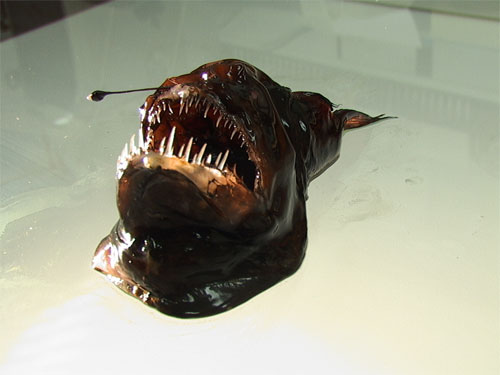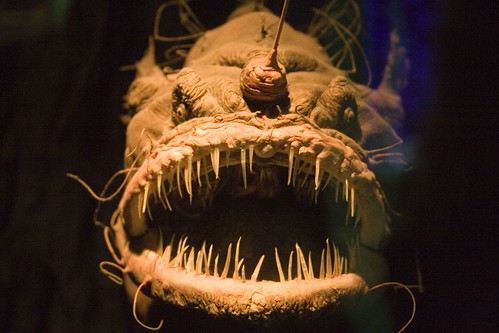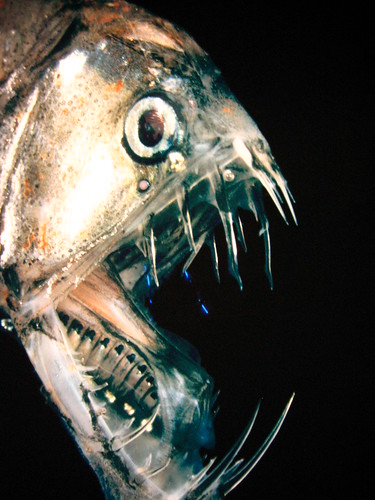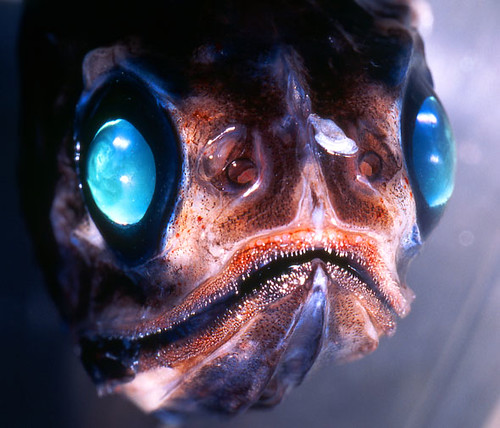 Looking like a creature from the Alien movies, this nightmarish "longhead dreamer" anglerfish (Chaenophryne longiceps) was until recently an alien species to Greenland waters
Looking like a creature from the Alien movies, this nightmarish "longhead dreamer" anglerfish (Chaenophryne longiceps) was until recently an alien species to Greenland waters 
New Shark Swimming off Greenland

This Portuguese dogfish is one of four such specimens found off Greenland since 2007.

The Mediterranean grenadier, or rattail (pictured with a gape-mouthed expression) was first spotted around Greenland in 1998, the new report says. Most of the new-to-Greenland deepwater species reported in the survey, such as this grenadier, are of little commercial value.
But an already evident influx of shallow-living, relatively warm-water fish have boosted the fortunes of the local fishing industry, study leader Peter Møller said.
For Greenland, at least, ocean warming "isn't necessarily bad—that's for sure," he said.
To: JoeProBono
What is this, a Helen Thomas lookalike contest?
2 posted on
04/26/2010 11:23:23 AM PDT by
Uncle Miltie
(http://www.teapartyslogans.com/cgi-bin/web/index.cgi)
To: JoeProBono
These are the “dork fish” that Bill Engval talks about in his comedy routine.
3 posted on
04/26/2010 11:23:43 AM PDT by
jrestrepo
(See you all in Galt's gulch)
To: JoeProBono
4 posted on
04/26/2010 11:24:14 AM PDT by
trisham
(Zen is not easy. It takes effort to attain nothingness. And then what do you have? Bupkis.)
To: JoeProBono
Never mind...

... just a beached whale.
5 posted on
04/26/2010 11:25:02 AM PDT by
theDentist
(fybo; qwerty ergo typo : i type, therefore i misspelll)
To: JoeProBono
My psychic abilities allowed me to accurately predict that “global warming” would be blamed, rather than acknowledging improvements in our research frequency and capabilities.
7 posted on
04/26/2010 11:27:07 AM PDT by
G Larry
(DNC is comprised of REGRESSIVES!)
To: JoeProBono
Maybe it would bite Sigorney Weaver’s liberal head off.
8 posted on
04/26/2010 11:31:56 AM PDT by
Frantzie
(McCain=Obama's friend. McCain & Graham = La Raza's favorite Senators)
To: JoeProBono
16 posted on
04/26/2010 11:41:36 AM PDT by
ETL
(ALL (most?) of the Obama-commie connections at my FR Home page: http://www.freerepublic.com/~etl/)
To: JoeProBono
To: JoeProBono
That Portugese dogfish looks like Jimmy Carter.
27 posted on
04/26/2010 12:02:51 PM PDT by
Beowulf9
To: JoeProBono

Humpback anglerfish
The female humpback anglerfish (Melanocetus johnsoni), shown here, is about the size of a tennis ball, with a large stomach and ferocious teeth like prison bars. Like many deep-sea fish it has watery flesh and light bones, and hangs in the water waiting for passing prey. The female also has a projecting lure with a light organ in the tip, and small eyes. The male is much smaller. Shaped like a jelly bean with fins, it has no lure, and a small mouth. In contrast to the female, it has muscles designed for swimming, and large eyes and nostrils. Whereas the female is equipped for efficient feeding, the male is designed for seeking out a female with which to breed. He follows the cues of her scent and lure, and once he finds her in the dark, he attaches himself with his hooked teeth and drinks her blood, and supplies sperm to fertilise her eggs.
http://www.teara.govt.nz/en/deep-sea-creatures/3/4
30 posted on
04/26/2010 12:16:25 PM PDT by
ETL
(ALL (most?) of the Obama-commie connections at my FR Home page: http://www.freerepublic.com/~etl/)
To: JoeProBono

Gulper eel
The strange gulper eel (Eurypharynx pelecanoides) is distinguished by its very large mouth and small body. The open mouth is 11 times the volume of the whole eel. This makes it possible to take occasional meals of small or large prey in an environment where food appears only rarely. It is thought to feed rather like a baleen whale, scooping the prey and the surrounding water, then squeezing the water out between its teeth and through its gills. Prey include crustaceans, fish, seaweed and cephalopods (including squid and octopus). It has tiny eyes on the tip of its snout, and a light organ on the tip of its tail, possibly to attract prey. It is most often found at depths between 1,000 and 2,100 metres. "
http://www.teara.govt.nz/en/deep-sea-creatures/3/3
35 posted on
04/26/2010 12:23:48 PM PDT by
ETL
(ALL (most?) of the Obama-commie connections at my FR Home page: http://www.freerepublic.com/~etl/)
To: JoeProBono

Saccopharynx lavenbergi
"You wouldn't want to meet a hungry Saccopharynx lavenbergi in the depths. These babies can reach six feet in length, have rows of sharp little teeth, and, like pythons of the deep, can swallow prey much fatter than themselves. They down victims whole, of course, which is why they're called "gulpers." They simply ease them through their "sack-gullet" (hence the term Saccopharynx) and into their stomach, where digestion takes over."
http://www.pbs.org/wgbh/nova/abyss/life/bestiary2.html
37 posted on
04/26/2010 12:28:30 PM PDT by
ETL
(ALL (most?) of the Obama-commie connections at my FR Home page: http://www.freerepublic.com/~etl/)
To: JoeProBono
38 posted on
04/26/2010 12:33:17 PM PDT by
mikrofon
(Schnozzolafish)
To: JoeProBono
Most all saltwater fish species have a good set of choppers.
Ever try to lip a spotted sea trout or speckled trout as we call 'em.
To: JoeProBono
I think the last one looks a lot like Walter.

To: JoeProBono
42 posted on
04/26/2010 12:48:58 PM PDT by
gogeo
("Every one has a right to be an idiot. He abuses the privilege!" Groucho Marx)
To: JoeProBono
45 posted on
04/26/2010 1:03:31 PM PDT by
ETL
(ALL (most?) of the Obama-commie connections at my FR Home page: http://www.freerepublic.com/~etl/)
FreeRepublic.com is powered by software copyright 2000-2008 John Robinson
 Looking like a creature from the Alien movies, this nightmarish "longhead dreamer" anglerfish (Chaenophryne longiceps) was until recently an alien species to Greenland waters
Looking like a creature from the Alien movies, this nightmarish "longhead dreamer" anglerfish (Chaenophryne longiceps) was until recently an alien species to Greenland waters 


















